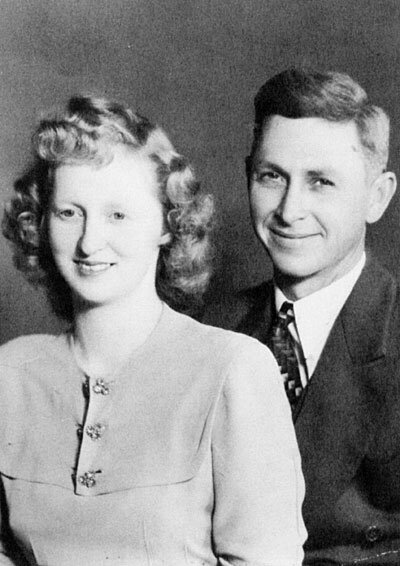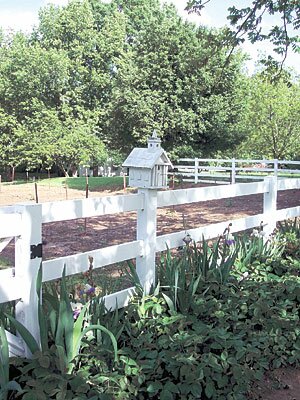It has been said that effort constitutes the defining line between those who dream and those who achieve. Gleason’s Roy Travillian is an achiever. He has not only dreamed great dreams, but through hard work and diligence, nurtured those dreams into reality. A spiritual and earnest man, he has lived a life that casts shadows on most. Laborer, farmer, salesman, business owner, college graduate at 68, author—-it’s easier to state what he hasn’t done rather than list all that he has accomplished. Quick to smile and even quicker to wit, Roy Travillian is a man with a story to tell.
 |

Roy and his grandson, Jamie Roney, who lives next door.
|
Parents
Roy’s mother and father, Elbert and Daisy Dean Hughes Travillian were wed on December 3, 1902 in the town of Piggott, Arkansas.
Elbert, a hard working and resourceful man, purchased 80 acres of land that joined his grandfather’s homestead. Clearing the land of large red and white oak and poplar trees, He planted successful crops of corn and cotton.
A good financial manager, Mr. Travillian saved money earned by his labor and reinvested to build a new home and stock barn.
Tragedy struck on a spring night in 1912 when the barn, livestock, hay and corn were totally consumed by fire. Sadly, no barn insurance was available at the time. Not inclined to give up, “Ebb” Travillian pooled his limited savings and purchased two mules. Motivated, he soldiered on, selling timber from the property and planting crops, until he recouped his loss and regained prosperity.
New Baby
Born on March 24, 1914, Roy was the fifth child born to the couple.
He said, “The day that I was born, Mama had three boys and one girl at the time, and every one of them had the measles.”
In June of 1914, tragedy struck the Travillian family again when a fierce storm destroyed their entire crop. “I was only a couple of months old at the time, but I remember hearing my family talking about it when I was older. The storm didn’t take down the house, but it took the crop,” he said.
After the storm, the family decided to leave Piggott. Mr. Travillian made hoops to cover his wagon, packed up his family and worldly belongings, and began the journey toward Tennessee.
Ferry Ride.
Arriving in Caruthersville, Missouri, on the second day of travel, the family camped that evening on the banks of the Mississippi River.
Early the next morning, aboard their heavily loaded two mule drawn wagon, they boarded a ferry to cross the river to Tennessee. Half way across, the ferry’s motor quit, causing the vessel to float downstream for nearly 12 miles. That evening, a small tug boat assisted in pushing the ferry to the shore, where the captain secured the vessel to a tree. Unable to safely leave the barge, the family and livestock spent a cold September night on the Missouri bank of the Mississippi river. With no way to build a fire aboard the ferry, Mrs. Travillian opened canned fruit to feed her family.
 |

Roy and his beloved wife, Elizabeth.
|
The next morning, a large tow boat hooked to the ferry and transported it back to the original starting point.
After repairs were made, the vessel transported the family to Tennessee.
After seven days travel, the family arrived in Dresden and camped overnight in Mr. Travillian’s uncle and aunt’s yard. The next day, he purchased a home for $400 with a crop still in field. Enlisting his sons, he harvested the crop. Utilizing the proceeds derived from the sale of the crop, he was able to not only purchase the home and land in full, but hay and corn to feed his stock until the next year’s harvest.
Tornado of 1917
Though only two and a half years old, Roy remembered the tornado that descended on Dresden in May of 1917. He recalled, “It was hot that day and my father stood at the back door and watched the clouds. He had mother on alert. All at once he told her to bring all the children and go down to the big gully. He and my brothers stayed at the house. He said he saw trees up in the air to the south of us. He told mother to take us to the house because it was going to hail. It sure did—-as large as golf balls. It beat our garden all to pieces.”
Shortly after the storm had passed, a neighbor ran up the road to their home and informed the family that the storm had hit a neighbor’s home and they were in need of help. Mr. Travillian and his sons immediately lent their assistance in freeing the family from the rubble of their house.
Roy recalled, “The tornado tore our corn stalks right out of the ground and removed the loose dirt. All the brush in the gully was spread out in the field.”
That fall, Mr. Travillian sold the farm at the behest of his homesick wife, who had just given birth to the family’s sixth child, a boy. Roy recalled that his mother, sister, baby brother and he rode the train back to Arkansas while his older brothers and father made the trip in two wagons. The farm, purchased for $400, sold for $5,000.
One year later, Mr. Travillian took a train trip to Tennessee to scout for a new farm and home. In short order, he purchased an 80 acre farm near Gleason, half of which was filled with expensive white oak timber. Summoning his family, the Travillians made their final move to Tennessee.
Roots in Tater Town

The Travillian's yard shows the fruits of Roy's labors. |
 |
Roy began his third grade school year at Gleason School, and attended there until graduating high school in 1933.
After graduation, he found work on a farm belonging to Mr. Calvin Terrell, making one dollar a day with board. The hours were long, from sunrise to sunset, six days a week. “I was young and healthy back then, so I didn’t mind.”
The wallet
One day, while working for Mr. Terrell, one of Roy’s fellow workers was severely injured. He said, “Mr. Terrell hired a man to help work the hay. I was driving a wagon what had two fiery mules and they were getting out of control. The new man was sitting on the side of the wagon with his feet hanging down, and a wheel ran over a stick, causing it to fly up and knock a hole through his leg.” He continued, “We stopped and carried the man to the house because he couldn’t walk. Mr. Terrell handed me his billfold and told me to take the man to the doctor and stay with him as long as I needed to and take the man home as he would not be able to work.”
Roy said that he only looked into the billfold when he was paying the doctor. It was full of ten, 20, and 50 dollar bills. “He could have sent one of those bills with me and it would have been enough. He knew how much money was in that wallet, and was trying me.”
Upon arriving back at the Terrell farm several hours later, he immediately returned the wallet and went back to work hauling hay. The next day, Roy was given the best job on the wagon in the field. After hay season ended, he went to McKenzie and began work as a salesman for Ward Coffee Company. He fondly remembered that Mr. Terrell came to visit him many times before his death a year or so later.
 Road Salesman
Road Salesman
Beginning July 4, 1935, Roy began running a sales route for Ward Coffee, earning an impressive salary of $12 a week. “I worked six days a week from daylight to dark. I was good at selling on the road.”
Saving his money, Roy purchased a brand new 1938 Chevrolet. He laughed, “It was no-frills—-no extras, no heater.”
It was during that time that Roy met Mary Elizabeth Owen. “She played basketball for Gleason, and when I bought my car, I looked her up. By 1940, we were going real steady.”
Draft Board
On December 8, 1941, one day after the Japanese had launched a deadly surprise attack on Pearl Harbor, Roy received a letter from the military informing him that he had been drafted. “The draft board classified me as 1-A, and ordered me to report to a doctor for a physical. I’d never been to a doctor before.”
The examination revealed that Roy’s heart was beating at 120 beats per minute, twice the normal pace. Two days later, the draft board sent me a card classifying me as 4-F.
Learning that Wolf Creek Arsenal in Milan was hiring, Roy immediately applied for a job and was hired on the spot.
He recalled, “You were actually classified as a military employee if you worked there, so the next thing I knew, I received another letter from the draft board informing me that I was re-classified as 1-A.”
Ordered by the military to undergo a second physical, Travillian traveled to Jackson to Dr. Fitts’ Clinic in Jackson. The initial exam by Dr. Fitts also revealed a super-fast heart rate. “The doctor told me to relax for a while and he would re-check my heartbeat. I guess I got too relaxed and went to sleep.” While Roy was dozing, the doctor again checked his pulse. “It was still 120 beats per minute. Three days later, the draft board sent me another letter telling me that they had changed my classification back to 4-F.
A member of the draft board told me to go back to work at the arsenal. I never heard from them again.”
The Marrying Kind
Following a three year courtship, Roy and Mary Elizabeth were wed on January 13, 1942.
At the time, Roy, employed as a guard at Wolf Creek, was working seven days a week on swing-shift. Mary Elizabeth was employed as a teacher at Liberty Four in Henry County.
March third, 1944, serves as a day of remembrance regarding two major events in Roy’s life: the birth of his first child and the huge plant explosion at the Milan Arsenal.
He recalled, “I wasn’t at work that day. I took the day off to be with my wife who was giving birth to our first child, Lynda.”
In time, the Travillian’s also welcomed children Carolyn (February 15, 1946), Beverly (August 22, 1946), and Bobby (March 13, 1951) to their family.
Switching Gears
At the conclusion of World War II, Roy was laid off from the Wolf Creek arsenal. “I was glad of it,” he reflected.
Seeking employment, Roy was hired by McKenzian Red Summers as a wholesale candy salesperson. “I was making good money at that job, $100 a week. I worked there for five years.”
In 1956, Roy was hired by good friend L. D. Folks, owner of Grapette Company, and given the opportunity to manage one of the company’s bottling plants located in Bardstown, Kentucky.
Roy was informed that the plant had been poorly managed in the past and that Mr. Folks wanted to revive the plant in order to sell it. If successful, Roy was to receive 25 percent of the sale. After much thought, he accepted the proposal. Working tirelessly, Travillian was able to restore the company’s sales and reputation. The plant was sold in December, 1956. Ready to move, the Travillians returned to Gleason in January 1957.
Company Man
Immediately upon moving back to Gleason, Roy acted upon his desire to start his own business. Purchasing a panel van to serve as the operation’s delivery vehicle, and seasoned by years of sales and management, Travillian traveled to Martin to speak with Fuller Brothers candy suppliers regarding acquisition of supplies. While there, he also secured a direct shipment deal with Planter’s Peanuts. A deal with Bradley Manufacturing was also secured in short order.
Enlisting the help of Bank of Gleason banker and brother-in-law Bob Owen, Roy sent letters to 14 distribution companies requesting they provide him with direct shipment of their products. Many of the companies agreed, solidifying his company’s supply requisition line. Owen also provided Travillian with a rating on Dunn and Bradstreet.
Remembering the business’ early days, Roy said, “I started out by placing small, minimum orders and borrowed a small amount from the bank to pay for the supplies. During that time, my wife got a job at the bank which kept the house going while I built up the business.”
Working diligently, Travillian expanded his operation rapidly. “I developed a large sales route and even hired others to help me sell, but none of them could sell like me. I did well.”
Later, Mary Elizabeth taught fifth grade at Gleason while Roy traveled and sold his wares. Amazingly, the couple helped four of their children and two sons-in-law attain college degrees, all at the same time.
Roy said that the next twenty years of his life passed by rapidly. “We worked all the time, and it was a family effort. Outside of the business, the only thing we had time for was church.”
Higher Education
Selling his business and retiring in 1976, Roy decided that it was time for his continue his education.
“I started taking Bible courses at Bethel College. One of my teachers encouraged me to get my degree, and I did.” He graduated in June of 1982 with a Bachelor of Science degree in Social Studies.
While there, another teacher encouraged Roy to write stories regarding some of the events that had occurred during his life. The result was Roy’s Tales, a truly fascinating book that was copywritten and published, and distributed in December, 1994. As a result of his endeavor, Bethel bestowed upon him an honorary doctorate degree.
Gardening Grandfather
Grandson Jamie Roney, who is employed as an admission counselor at Bethel, lives with wife Jennifer in a home adjoining Roy’s property. Jamie said, “My wife and I often hear Granddaddy start up his tiller early in the morning.” Smiling, he continued, “He’s 92 years old and still does his own tilling and gardening, and always has a great crop of tomatoes.” An avid flower gardener, Roy’s yard fence line is home to a beautiful array of healthy, colorful plants.
Watching grandfather and grandson interact, their fondness for each other is unmistakable.
Smiling, Roy reflected, “When Jamie was little, he lived in Alabama. Every time he would come to visit, I’d take a whisk broom and pretend to sweep all that bad Alabama dirt off of him.” He added, “Before he would leave to go home, we would blow up paper bags so he could have some “Tennessee air” to take home with him.”
Known for purchasing the first Bethel basketball season ticket every year, Roy shows only subtle signs of slowing down. Despite the loss of beloved wife, Mary E., on June 29, 2004, Roy continues to live each day with faith and purpose.
Inspiration for All
One could learn a great deal by examining the life of Roy Travillian. In an age where complacency at work and home is swiftly becoming the accepted norm, he stands as a reminder of different days; when persistence, hard work, dedication to family and God, sacrifice for others, and an unbridled spirit of self reliance defined the American working man. Let us hope that he is not the last of his kind, for the world would be far less without the likes of him. Source: McKenzie Banner.
Home About Us
About Us Gleason Businesses
Gleason Businesses Churches
Churches Gleason School
Gleason School Obituaries
Obituaries Pictures
Pictures Gleason News
Gleason News Contact Us
Contact Us
Copyright © 2003 - 2006 www.GleasonOnline.comTM. All rights reserved.